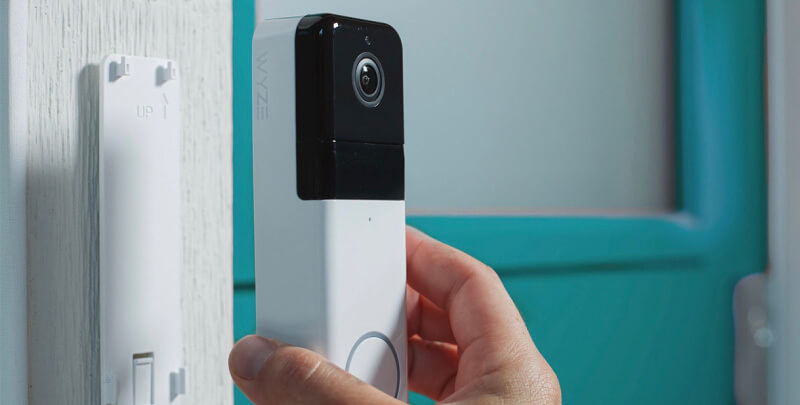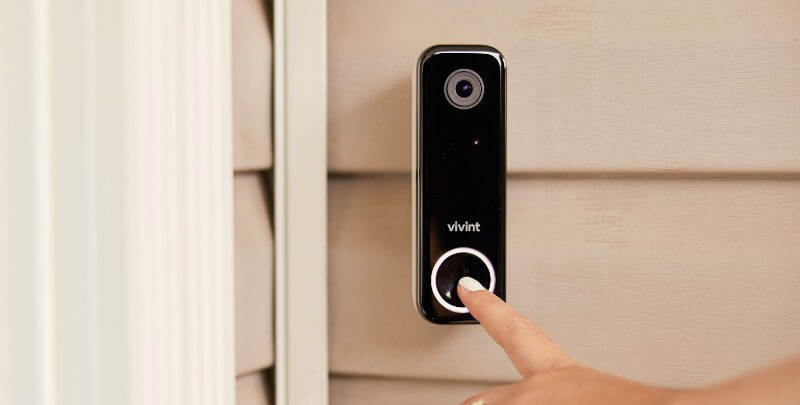All You Need to Know About Doorbell Cameras

In an era where innovative technology continues transforming our homes, doorbell cameras have become a pivotal addition to modern home security. Gone are the days when a doorbell rang to announce a visitor's presence.
Gone are the days when a doorbell rang to announce a visitor’s presence. Today, doorbell cameras offer homeowners a multifaceted solution, combining the functionality of a traditional doorbell with the surveillance prowess of a sophisticated camera system.
The Technology Behind Doorbell Cameras
These innovative devices provide a seamless way to monitor and interact with visitors, track package deliveries, and ensure the security of our homes—all accessible from the convenience of our smartphones or connected devices.
They stand as a testament to the evolving landscape of smart home technology for security and comfort, offering peace of mind and control over who enters our personal space, whether at home or miles away.
Throughout this comprehensive guide, we’ll navigate the intricacies of doorbell cameras, exploring how they work, the different types available, installation procedures, key features and functions, security considerations, maintenance tips, real-life applications, and a glimpse into the exciting future developments awaiting this technology.
Definition of Doorbell Cameras
Doorbell cameras represent a fusion of conventional doorbell mechanisms with sophisticated surveillance capabilities. These devices provide seamless integration of a doorbell’s fundamental alert system and the advanced features of a security camera.
By combining the functionality of a traditional doorbell with a built-in camera, these intelligent doorbells, doorbell cameras, and devices enable homeowners to remotely observe and communicate with visitors, whether at home or away.
This technological innovation offers users a real-time visual and audio connection through their doorbell cameras, recorders, smartphones, or other interconnected devices, providing a heightened sense of control and security over their homes.
Importance and Benefits
The significance of doorbell cameras in today’s home security landscape cannot be overstated. They serve as a proactive means to enhance the security infrastructure of residences.
These devices act as a deterrent against potential intruders by providing homeowners with constant monitoring and alerts, enabling swift responses to visitors or package deliveries.
Whether anticipated or unexpected, the immediate visual identification of visitors empowers homeowners to make informed decisions about granting access or alerting authorities if necessary. Moreover, notice the convenience; these systems enable users to monitor their properties remotely, providing peace of mind and control over home security regardless of physical location.
How Doorbell Cameras Work
Doorbell cameras operate through a sophisticated combination of technology that seamlessly integrates traditional doorbell functions with advanced surveillance features. Here’s a breakdown of how doorbell cameras work and record their operational mechanisms:
1. Camera and visual capturing: A fundamental component of wireless video doorbells and cameras is the built-in camera, typically equipped with high-definition video capabilities. When the wireless video doorbell is activated—either by a visitor ringing it or through motion detection— it begins to capture live footage of the surroundings.
2. Connectivity and wireless transmission: The devices are designed to connect to a homeowner’s Wi-Fi network. The captured live video feed is transmitted wirelessly to a user’s connected smartphone or other devices through an accompanying app. It allows homeowners to view the live stream remotely, whether at home or away.
3. Motion sensors and alerts: Motion sensors equipped in many doorbell cameras activate the camera to start recording whenever they detect motion in the field of view. This functionality helps alert owners about visitors or potential intruders before they ring the doorbell.
4. Two-way audio communication: In addition to the Ring Video Doorbell Pro and feed, Ring Video Doorbell and cameras also feature two-way audio communication. This means homeowners can see the visitor and communicate with them in real time through a built-in microphone and speaker. Whether it’s giving instructions to a delivery person or conversing with a friend at the next ring video doorbell pro again, this feature offers added convenience and security.
5. Remote access and control: Through the connected app, users can view and communicate with the video doorbell camera and control various settings of the smart video doorbell and camera settings. It includes adjusting motion detection settings, configuring alerts, and managing stored video footage.
6. Power source: Doorbell cameras can be either wired or wireless. Wired models are connected to the home’s existing electrical system, ensuring a continuous power supply. Wireless versions operate on batteries or other rechargeable batteries as power sources, offering flexibility in placement without the need for hardwiring.
7. Cloud storage and local storage options: Most doorbell cameras offer free cloud storage for recorded footage, allowing users to access and review footage remotely. Some models also provide a local warehouse and video storage options via SD cards, offering additional security for video recordings.
8. Integration with smart home ecosystems: Many other video doorbells and cameras can be integrated into broader smart home systems, allowing them to work with other smart devices such as smart locks, lights, or home security systems. This interconnectedness enhances the overall security and convenience of the homeowner’s living space.
This amalgamation of features and functionalities enables smart doorbells and cameras to serve as a versatile and robust tool in home security, providing real-time monitoring and interactivity while offering homeowners convenience and peace of mind.

Description of the Technology Behind Doorbell Cameras
Doorbell cameras utilise a combination of Wi-Fi, motion sensors, HD cameras, and two-way audio communication. These devices connect to a homeowner’s network, allowing live video and audio transmission from ring doorbells to a connected mobile application.
Components and Their Functions
Critical components of smart doorbell cameras may include the camera lens, microphone, speaker, motion sensors, and connectivity module. The camera captures video, the microphone and speaker enable communication, ring video doorbell calls, and the motion sensors trigger alerts.
Explanation of Connectivity and Setup
These two battery-powered doorbell devices typically connect to a home’s Wi-Fi network. The setup involves installing an app, connecting the doorbell to the app, and configuring settings to tailor the battery-powered doorbell device to the homeowner’s preferences.
Types of Doorbell Cameras
From wired to wireless, smart to traditional, we delve into the functionalities and features defining the spectrum of doorbell camera options.
Wired vs. Wireless Doorbell Cameras:
- Wired doorbell cameras: Typically, a home’s existing electrical systems or doorbell wiring hardwire these systems. They draw power directly from the home’s electrical system, ensuring a constant power supply. Wired doorbell cameras provide continuous functionality without frequent battery changes or recharging. They offer a reliable and consistent power source, making them a robust choice for homeowners seeking uninterrupted surveillance.
- Wireless doorbell cameras: In contrast, wireless doorbell cameras operate on batteries or rechargeable power sources. The wireless nature of these devices allows greater flexibility in placement and installation, as they are not bound by existing wiring. Users can easily install these models and relocate them as needed. However, their reliance on batteries or periodic recharging requires regular maintenance to ensure uninterrupted functionality.
Each type presents distinct advantages and limitations, catering to different homeowner preferences and specific needs. Wired systems offer reliability and a constant power source, while wireless systems provide flexibility and easier installation.
Installation Process
Installing a doorbell camera by professionals typically follows a series of steps to ensure the best doorbell camera for proper functioning and security. Here’s a general overview:
- Assessment and planning: Professionals start by assessing the location and identifying the best placement for the best video doorbell camera. They consider factors like visibility, coverage, and accessibility.
- Power source: Doorbell cameras may be wired or battery-powered. Professionals will check the existing video doorbell camera wiring and power supply if wired. If the camera is battery-powered, they ensure to charge it fully.
- Mounting the camera: The cameras are mounted securely at the chosen location. It may involve drilling holes into the wall or door frame.
- Connecting to Wi-Fi: Professionals connect the video doorbell pro camera to the Google Home app via the homeowner’s Wi-Fi network. This step is crucial for remote monitoring and alerts.
- Integration with smart home systems: If the doorbell camera is part of a more extensive smart home system, professionals integrate it with other devices for seamless operation.
- Adjusting settings: Professionals configure camera settings, such as motion detection sensitivity, notification preferences, and video quality.
- Testing: Before installing, professionals test the ring doorbells and cameras to ensure they function correctly. They check live streaming, motion detection, and alert notifications.
- User training: If required, professionals may provide basic user training to homeowners. It includes using and adjusting the camera’s settings and accessing recorded footage.
- Cleanup: Once everything is in order, professionals clean up the installation area, removing debris or packaging materials.
- Documentation: Professionals may provide documentation, including user manuals and warranty information, to the homeowner.
- Final checks: Before leaving, professionals ensure the front doorbell camera is fully operational.
Keep in mind that the specific steps can vary based on the brand and model of the doorbell camera, as well as any unique features it may have. Hiring professionals ensures a proper installation, reducing the risk of technical issues and ensuring the security system works as intended.
Wiring and Power Requirements
- Wired doorbell cameras: Installation of wired doorbell cameras requires a level of expertise in electrical wiring. It’s crucial to follow the manufacturer’s instructions carefully and, if uncertain, consider professional installation.
- Wireless doorbell cameras: Wireless models are easier to install as they don’t require complex wiring. However, they need periodic battery changes or recharging to ensure uninterrupted functionality.
Troubleshooting Common Installation Issues
- Wi-Fi connectivity problems: Check your Wi-Fi signal strength and ensure the doorbell camera is within the network’s range.
- Improper wiring: Verify that you have correctly installed the wiring according to the manufacturer’s instructions.
- Compatibility issues: Ensure that the doorbell camera is compatible with your existing system or devices and make any necessary adjustments in settings.
Security and Privacy Considerations
- Data protection and encryption: Security measures include encrypted transmissions and secure cloud storage to protect data from unauthorised access.
- Potential vulnerabilities and how to mitigate them: Regular software updates, strong passwords, and enabling two-factor authentication can mitigate vulnerabilities such as hacking or signal interception.

Tips for Securing Doorbell Camera Systems
- Change default passwords: One of the primary steps towards securing any smart device, including a doorbell camera, is to change the default password immediately upon installation. Create a robust and unique password that combines letters, numbers, and special characters.
- Regularly update firmware and software: Keep the doorbell camera’s firmware and the accompanying app/software current. Manufacturers often release updates to address security vulnerabilities and enhance the device’s performance. Regular updates help protect against potential threats.
- Set up alerts for unusual activities: Take advantage of the alerts and notifications offered by the doorbell camera. Configure alerts for unusual activities, such as multiple failed login attempts or potential tampering with the device. It enables timely responses to potential security breaches.
- Position the camera: Position the cameras to capture the necessary areas without compromising your or your neighbours’ privacy. Be mindful of the field of view to prevent unintentional surveillance of private spaces.
- Regularly review access and user permissions: Review who can access the doorbell camera system. Remove any unnecessary users or devices that no longer require access. The system prevents unauthorised entry.
- Physical security measures: Consider physical security measures such as tamper-resistant hardware or enclosures for the doorbell camera to prevent easy removal or tampering.
Implementing these security practices helps safeguard your front door/bell camera system, enhance overall home security, and protect your privacy.
Maintenance and Care
- Cleaning and upkeep of the camera and system: Regular camera lens cleaning and system maintenance ensure optimal performance and clear footage.
- Firmware updates and software maintenance: Regularly install firmware updates to keep the device up-to-date and secure from potential vulnerabilities.
- Extending the lifespan of your doorbell camera: Avoid extreme temperatures, follow manufacturer guidelines for usage, and perform routine checks to prolong the device’s lifespan.
Real-life Applications and Success Stories
Doorbell cameras have shown remarkable practical applications and have been pivotal in real-life scenarios, aiding homeowners in multiple ways:
- Preventing thefts: In numerous instances, doorbell cameras have acted as a deterrent to potential thefts. Visible doorbell cameras often dissuade package thieves or intruders, as they know they’re being recorded and monitored. There have been cases where the mere presence of a doorbell camera has prevented theft attempts.
- Identifying intruders: In cases of break-ins or attempted burglaries, doorbell cameras have captured clear video footage of intruders, aiding law enforcement in identifying and apprehending the culprits.
- Providing evidence to law enforcement: Doorbell cameras have been crucial evidence in legal proceedings. Video footage has been used in court to support claims, identify perpetrators, and validate the sequence of events.
Innovations in Doorbell Camera Technology
- AI-powered features: Anticipate the integration of advanced artificial intelligence for more sophisticated facial recognition, improved motion detection, and better alerts for enhanced security.
- Higher resolutions: Expect doorbell cameras to offer even higher resolutions, leading to more precise and detailed images and video footage.
- Enhanced connectivity: Continual advancements in connectivity protocols ensure seamless interaction between the device and other smart home systems.
Predictions for the Future of Doorbell Cameras
- Improved functionalities: Foresee a broader range of functionalities and more intuitive user experiences as these devices evolve.
- Increased affordability: Expect technological advancements to lead to more affordable doorbell camera systems, making them accessible to a broader consumer base.
- Wider adoption: Forecasts suggest a broader acceptance and integration of doorbell cameras into homes, becoming a common feature in residential security setups.
Upcoming Features and Advancements
- Facial recognition: Integrating more advanced facial recognition technology for improved security measures and personalised alerts.
- Enhanced AI capabilities: Expect developments in AI capabilities to provide more accurate and relevant alerts, reducing false alarms.
- Improved battery life in wireless models: Advancements in battery technology will lead to longer-lasting battery life in wireless doorbell cameras, reducing maintenance requirements and providing continuous surveillance.
These future trends and anticipated advancements demonstrate the evolving nature of wired video doorbells and cameras, moving towards more efficient, secure, and user-friendly systems that will likely become a mainstream component of modern home security.
Invest in Doorbell Cameras
In our comprehensive exploration of the best doorbell cameras around, we’ve delved into the intricacies of this innovative technology, unravelling its functions, applications, and future potential. Let’s recap the key points discussed and offer final thoughts on the best video doorbell cameras and recommendations for them.
Looking ahead, we’ve shed light on future trends, anticipating remarkable advancements in doorbell camera technology, from AI-powered features to increased affordability.
In the modern world, doorbell cameras are a beacon of security and convenience. Their multifaceted nature, real-time monitoring, two-way communication, and deterrent capabilities make them essential to any home security system.
We encourage homeowners to embrace these devices for enhanced security and peace of mind. When considering the right doorbell camera, it’s essential to assess individual needs, from power sources to desired features, ensuring a tailored solution for your home.
We encourage further exploration into the world of doorbell cameras. Ask questions, seek advice from professionals and experts, and consider investing in a doorbell camera system that meets your unique requirements.
Whether it’s to fortify your home security or add an element of convenience to your daily life, a doorbell camera might be the missing piece to your household’s safety puzzle.
This comprehensive guide aims to engage and inform, empowering readers to make informed decisions about home security to ensure a safer, more intelligent, and more connected living space.
Please note: This information is provided for advice purposes only. Regulations differ from state to state, so please consult your local authorities or an industry professional before proceeding with any work. See After Hours Electrical’s Terms & Conditions here.